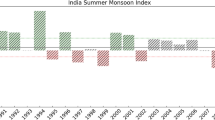Abstract
Based on the simulations of cloud features in February 2001 by the regional numerical weather prediction model—Advanced Regional Eta-coordinate Model (AREM), the dynamic and thermodynamic conditions for middle cloud formation over eastern China are studied. Diagnostic analysis partly confirms the previous suggestion that the middle stratiform clouds downstream of the Tibetan Plateau are maintained by the frictional and blocking effects of the plateau. In addition, it is found that the temperature inversion at plateau height over eastern China generated by the warm air advected from the plateau provides a favorable thermodynamic condition for middle clouds. Both diurnal variations of the mid-level divergence and the inversion over eastern China, which are determined by the atmospheric boundary activity over the Tibetan Plateau, dominate the cloud diurnal cycle. The middle cloud amount decreases and the cloud top falls in the daytime, but reverses at night. The comparison of cloud features between the simulations and the observations also proves that the AREM can well capture the distinctive continental stratiform cloud features downstream of the Tibetan Plateau.
Similar content being viewed by others
References
Betts, A. K., 1986: A new convective adjustment scheme, Part I: Observational and theoretical basis.Quart. J. Roy. Meteor. Soc.,112, 677–691.
Dai Yongjiu, and Zeng Qingcun, 1998: A land-surface model (IAP94) for climate studies, Part I: Formation and validation in off-line experiments.Adv. Atmos. Sci.,14, 433–460.
Doutriaux-Boucher, M., and G. Seze, 1998: Significant changes between the ISCCP C and D cloud.Climatologies. Geophys. Res. Lett.,25, 4193–4196.
Edwards, J. M., and A. Slingo, 1996: Studies with a flexible new radiation code. I: Choosing a configuration for a large-scale model.Quart. J. Roy. Meteor. Soc.,122, 689–719.
Holtslag, A. A. M., and B. A. Boville, 1993: Local versus nonlocal boundary-layer diffusion in a global climate model.J. Climate,6, 1825–1842.
Ju Lixia, Lei Xiaoen, and Han Zhiwei, 2003: Nested meteorological model system for air pollution prediction.Journal of the Graduate School of the Chinese Academy of Sciences,20, 470–476. (in Chinese)
Klein, S. A., and D. L. Hartmann, 1993: The seasonal cycle of low stratiform clouds.J. Climate,6, 1587–1606.
Li Yunying, Yu Rucong, Xu Youping, and Zhang Xuehong, 2003: The formation and diurnal changes of stratiform clouds in southern China.Acta Meteorologica Sinica,61, 733–743. (in Chinese)
Li, Y. Y., R. C. Yu, Y. P. Xu, and X. H. Zhang, 2004: Spatial distribution and seasonal variation of cloud over China based on ISCCP data and surface observations.J. Meteor. Soc. Japan,82, 761–773.
Lin, W. Y., and M. H. Zhang, 2004: Evaluation of clouds and their radiative effects simulated by the NCAR Community Atmospheric Model CAM2 against satellite observations.J. Climate,17, 3302–3318.
Morcrette, J.-J., and Y. Fouquart, 1986: The overlapping of cloud layers in short radiation parameterizations.J. Atmos. Sci.,4, 321–328.
Reynolds, R. W., N. A. Rayner, T. M. Smith, D. C. Stokes, and W. Wang, 2002: An improved in situ and satellite SST analysis for climate.J. Climate,15, 1609–1625.
Rossow, W. B., and R. A. Schiffer, 1991: ISCCP cloud data products.Bull. Amer. Meteor. Soc.,72, 2–20.
Rossow, W. B., and R. A. Schiffer, 1999: Advances in understanding clouds from ISCCP.Bull. Amer. Meteor. Soc.,80, 2261–2287.
Siebesma, A. P., and Coauthors, 2003: A large eddy simulation intercomparison study of shallow cumulus convection.J. Atmos. Sci.,60, 1201–1219.
Sun, Z. A., and L. Rikus, 1999: Improved application of exponential sum fitting transmissions to inhomogeneous atmosphere.J. Geophys. Res.,104D, 6291–6303.
Weare, B. C., 2004: A comparison of AMIP II model cloud layer properties with ISCCP D2 estimates.Climate Dyn.,22, 281–292.
Webb, M., C. Senior, S. Bony, and J.-J. Morcrette, 2001: Combining ERBE and ISCCP data to assess clouds in the Hadley Center, ECMWF and LMD atmospheric climate models.Climate Dyn.,17, 905–922.
Williams, K. D., M. A. Ringer, and C. A. Senior, 2003: Evaluating the cloud response to climate change and current climate variability.Climate Dyn.,20, 705–721.
Xu, K. M., and D. A. Randall, 1996: A semiempirical cloudiness parameterization for use in climate models.J. Atmos. Sci.,53, 3084–3102.
Xu Youping, Xia Daqing, and Qian Yueying, 1998: The water-bearing numerical model and its operational forecasting experiments. Part II: The operational forecasting experiments.Adv. Atmos. Sci,15, 321–336.
Yu Rucong, 1994: Two-step shape-preserving advection scheme.Adv. Atmo. Sci,11, 479–490.
Yu Rucong, Zeng Qingcun, Peng Guikang, and Chai Fuxing, 1994: Research on “ Ya-An-Tian-Lou”. Part II: Numerical trial forecasting.Chinese J. Atmos. Sci.,13, 145–158. (in Chinese)
Yu Rucong, Yu Yongqiang, and Zhang Minghua, 2001: Comparing cloud radiative properties between the eastern China and the Indian monsoon region.Adv. Atmos. Sci,18, 1090–1102.
Yu Rucong, Xue Jishan, and Xu Youping, 2004:AREMS Meso-scale Heavy Rainfall Numerical Prediction Model System. China Meteorological Press, Beijing, 232pp. (in Chinese)
Zhang Liping, Chen Wanchun, Xia Jun, Niu Cunwen, and Song Xingyuan, 2003: Numerical simulation study on developing process of drought disaster.Engineering Journal of Wuhan University,36, 24–27. (in Chinese)
Zhong Xiaoping, and Qing Qingtao, 2001: Numerical simulation of precipitation in the eastern Tibetan Plateau with LASG mesoscale model and its operational application evaluation.Quarterly Journal of Applied Meteorology,12, 167–175. (in Chinese)
Author information
Authors and Affiliations
Corresponding author
Rights and permissions
About this article
Cite this article
Yunying, L., Rucong, Y., Youping, X. et al. AREM simulations of cloud features over eastern China in February 2001. Adv. Atmos. Sci. 22, 260–270 (2005). https://doi.org/10.1007/BF02918515
Received:
Revised:
Issue Date:
DOI: https://doi.org/10.1007/BF02918515



